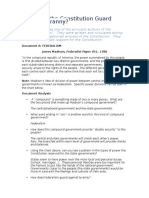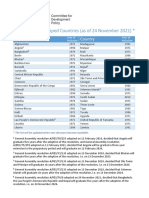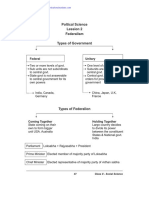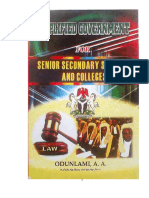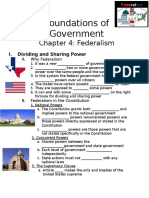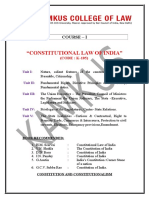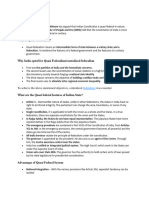Reflections On The Quasi-Federal Democracy
Uploaded by
Aruna PadalaReflections On The Quasi-Federal Democracy
Uploaded by
Aruna PadalaReflections On The Quasi-Federal Democracy
drishtiias.com/daily-updates/daily-news-editorials/reflections-on-the-quasi-federal-democracy
Parliamentary disruption is quite a common phenomenon in the Indian political system.
Amidst the disruption, a large number of Bills affecting the federal structure of the State
(for eg. the three Farm Laws Bills), have been passed without any deliberation in the
Parliament.
This has raised several issues with respect to structural flaws in India’s Federal democracy
which require serious consideration.
Indian Federalism
Federalism in essence is a dual government system, constituting a Centre and a
number of States.
Unique Characteristics of Indian Federalism: Apart from the above
Characteristics, Indian Federalism also has the below mentioned features:
Single Constitution: In India, there is only one Constitution. It is applicable
to both the Union as a whole and the States. In a true federation, there are
separate Constitutions for the Union and the States.
Division of Power: In a federation, power is divided equally between
the two governments.
But in India, the Central government has been given more powers and
made stronger than the State governments. (In the Union List of
Schedule 7, there are more and important items than in the
State List)
Constitution is not strictly rigid: The Constitution of India can be
amended by the Indian Parliament as per the needs of time.
On many subjects, the Parliament does not need the approval of the
State legislatures to amend the Constitution. (Article 3 allows
alteration of areas, boundaries or names of existing States).
However, on certain subjects affecting States’ functions and rights, the
consent of half the States is necessary. (Article 368 of the
Constitution)
Unified Judiciary: India has a unified or integrated judicial system. The
High Courts which are the highest Courts in the State come under the
Supreme Court in the hierarchy.
Single Citizenship: Indian States do not provide separate citizenship (Single
Citizenship under Part II of the Constitution).
All the Indian citizens are the citizens of State. This is unlike USA,
where there is dual citizenship: one, federal and the other, State.
1/3
Nature of Indian Constitution
Federal theorist K.C. Wheare has argued that the nature of Indian
Constitution is quasi-federal in nature.
The SC in S R Bommai vs Union of India (1994), a nine-judge Bench of
Supreme Court held federalism a part of the Basic Structure of the
Constitution.
The SC in Sat Pal v State of Punjab and Ors (1969), held that the
Constitution of India is more Quasi-federal than federal or unitary.
Benefits of a Quasi Federal System
National Integration: The Constituent Assembly’s decision to not create a
true federation was taken after looking at the precarious situation of the time.
With creation of Pakistan, a Nation created on the basis of religion, there were
voices of separate Nation States in other states too. As a result, various
provisions like Article 356 were added. A federal structure with unitary
features allowed scope for such maneuver.
Cooperation and Coordination: A Quasi Federal structure allows Centre to
coordinate National level programmes like Pulse Polio Programme.
The recent case of allocation of oxygen to different States as per their
requirement during Covid-19 was possible because of a Central authority.
Single Market Economy: Having a quasi federal structure allows India to be a
single market for the World. The recent introduction of Goods and Services Tax
(GST) has allowed creation of India as a single market.
Moreover, there is a single Income Tax in all of India and the States do not
have power to impose it. Thus, Indian citizens are saved from double taxation.
Procedural Ease: The Indian Parliamentary system with its bicameral
legislature allows for easy passage of law as compared to passage in a true
federation like the USA.
A bicameral legislature also ensures proper representation of States in the
Upper House.
Resolving Inter State Conflicts: A quasi federal structure allows centre to act
as an arbiter in case of Inter State dispute. For eg, Border dispute and River
Water dispute (Article 262 Constitution of India: Adjudication of
disputes relating to waters of inter-State rivers or river valleys).
Challenges of Quasi Federal system
Abuse of Power by Centre: The federal provisions of the Constitution can only
be amended with consent of the States. Schedule 7 of the Constitution provides for
a separate List for Centre and State.
However, the Centre regularly violates the provision by legislating on State
subjects. For eg, the recent Farm Laws.
2/3
Office of Governor: The power vested upon the governor by the Article 154 of
the Indian Constitution states that all the executive powers of the state are held
by him.
This provision implies that the Governor can appoint the Chief Minister and
the Advocate General of the State, and State Election Commissioners. This has
been frequently misused by the Centre to favour its State unit or a regional
Party which is in coalition to it.
The most paramount executive power at his disposal is that he can
recommend the imposition of constitutional Emergency in a state.
Regionalism: Regionalism establishes itself through demands for autonomy on
the grounds of language, culture etc.
The nation thus faces the challenge of internal security in the form of
insurgency and this causes upheavals in the basic notion of Indian federation.
Conclusion
The Chairman of Drafting Committee, Dr. Ambedkar had rightly said that, “Our
Constitution would be both unitary as well as federal according to the requirements of
time and circumstances”
In view of the above, It would be more apt to consider Indian federalism as a separate
type of federalism or Federalism sui generis.
3/3
You might also like
- The Subtle Art of Not Giving a F*ck: A Counterintuitive Approach to Living a Good LifeFrom EverandThe Subtle Art of Not Giving a F*ck: A Counterintuitive Approach to Living a Good Life4/5 (6418)
- The Gifts of Imperfection: Let Go of Who You Think You're Supposed to Be and Embrace Who You AreFrom EverandThe Gifts of Imperfection: Let Go of Who You Think You're Supposed to Be and Embrace Who You Are4/5 (1173)
- Never Split the Difference: Negotiating As If Your Life Depended On ItFrom EverandNever Split the Difference: Negotiating As If Your Life Depended On It4.5/5 (992)
- The Hard Thing About Hard Things: Building a Business When There Are No Easy AnswersFrom EverandThe Hard Thing About Hard Things: Building a Business When There Are No Easy Answers4.5/5 (361)
- Hidden Figures: The American Dream and the Untold Story of the Black Women Mathematicians Who Helped Win the Space RaceFrom EverandHidden Figures: The American Dream and the Untold Story of the Black Women Mathematicians Who Helped Win the Space Race4/5 (1016)
- Devil in the Grove: Thurgood Marshall, the Groveland Boys, and the Dawn of a New AmericaFrom EverandDevil in the Grove: Thurgood Marshall, the Groveland Boys, and the Dawn of a New America4.5/5 (279)
- A Heartbreaking Work Of Staggering Genius: A Memoir Based on a True StoryFrom EverandA Heartbreaking Work Of Staggering Genius: A Memoir Based on a True Story3.5/5 (233)
- General Principles of Constitutional and Administrative Law. Ohn Alder PDF100% (2)General Principles of Constitutional and Administrative Law. Ohn Alder PDF639 pages
- Legal Framework For Regional Planning Authority-1No ratings yetLegal Framework For Regional Planning Authority-123 pages
- Will Storey-US Government and Politics (Politics Study Guides) (2007) .16-40No ratings yetWill Storey-US Government and Politics (Politics Study Guides) (2007) .16-4025 pages
- CBSE Class 10 SST Notes Question Bank Federalism100% (1)CBSE Class 10 SST Notes Question Bank Federalism10 pages
- (Original PDF) An Introduction to Government and Politics: A Conceptual Approach 9th Edition - The full ebook with all chapters is available for download now100% (1)(Original PDF) An Introduction to Government and Politics: A Conceptual Approach 9th Edition - The full ebook with all chapters is available for download now55 pages
- Foundations of Government: Chapter 4: FederalismNo ratings yetFoundations of Government: Chapter 4: Federalism8 pages
- Functions and Responsibilities of The Union and The States100% (1)Functions and Responsibilities of The Union and The States12 pages
- The Shifting Dynamics of Centre-State RelationshipNo ratings yetThe Shifting Dynamics of Centre-State Relationship35 pages
- The Practical Aspects of Gun Control Part 3No ratings yetThe Practical Aspects of Gun Control Part 36 pages
- Class X Social Science (Code 087) Sample Question Paper 2018-19No ratings yetClass X Social Science (Code 087) Sample Question Paper 2018-1915 pages




